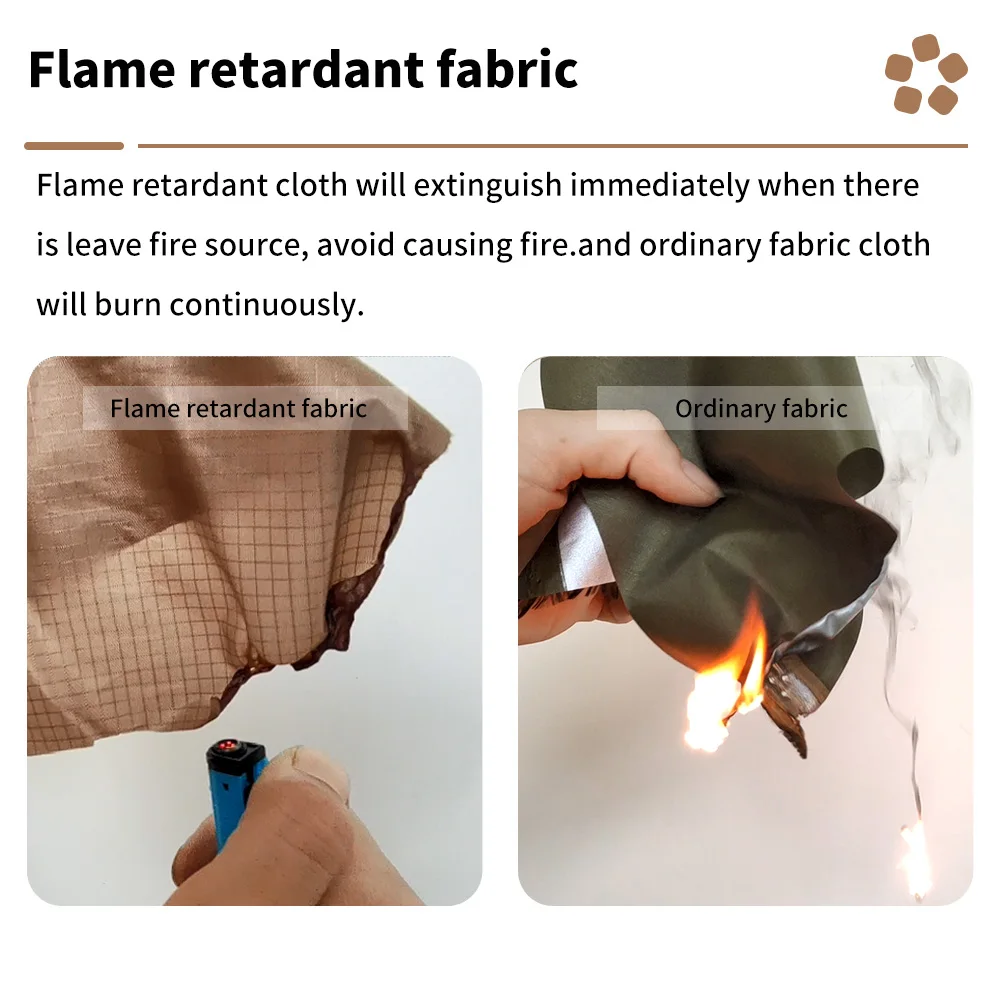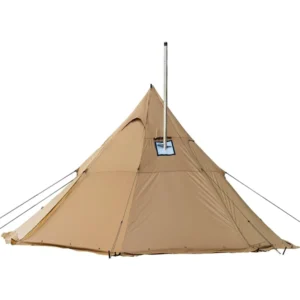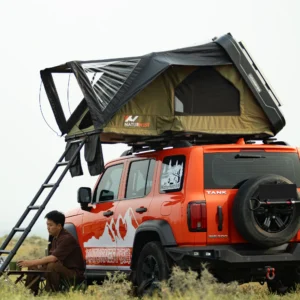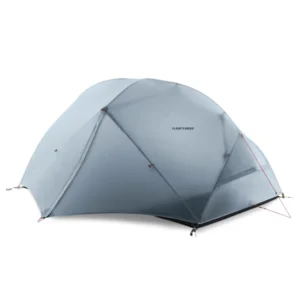1. Understanding the Four-Season Tent: Purpose-Built Protection
Four-season tents represent the pinnacle of outdoor shelter engineering, designed specifically to withstand nature’s most extreme challenges. Unlike their three-season counterparts, these specialized shelters are built from the ground up with one primary goal: to provide reliable protection in harsh, unforgiving environments where standard camping equipment would fail.
The fundamental difference between four-season and three-season tents lies in their design philosophy. While three-season tents prioritize ventilation, lightweight materials, and ease of setup for mild conditions, four-season models focus on structural strength, weather resistance, and insulation to handle extreme situations. This distinction manifests in every aspect of their construction, from pole architecture to fabric selection.
These robust shelters are intended for specialized usage scenarios including:
- High-altitude mountaineering expeditions
- Winter camping in snow and sub-freezing temperatures
- Alpine adventures with exposure to high winds
- Extended stays in harsh, remote environments
In these challenging conditions, a specialized tent isn’t just about comfort—it’s about survival. Durable tents for all seasons provide essential protection, but four-season models take this protection to another level entirely. The difference becomes clear when you consider the performance requirements: while a three-season tent might handle light snow and moderate winds, a true four-season tent can withstand:
- Temperatures well below 0°F (-18°C)
- Sustained winds exceeding 40-50 mph (64-80 km/h)
- Heavy snow loads that would collapse standard tents
- Driving rain and sleet from multiple directions
The specialized design elements of four-season tents built for durability create a reliable barrier between you and potentially life-threatening conditions, making them an essential investment for serious winter adventurers and mountaineers rather than a luxury.
2. Essential Pole Structure Features: The Backbone of Stability
The pole system serves as the literal backbone of any four-season tent, providing the structural integrity required to withstand extreme conditions. These critical components are engineered with significantly different specifications than those found in standard camping tents.
Four-season tents typically utilize high-strength materials for their poles, with premium aluminum alloys (often 7000-series aluminum) being the most common choice. The advantages include exceptional strength-to-weight ratio and reliable performance even in extreme cold, where lesser materials might become brittle. For specialized expedition tents, carbon fiber poles offer even greater strength with reduced weight, though at a premium price point.
Beyond materials, the pole configuration makes a fundamental difference in tent performance:
- Geodesic designs use intersecting poles that create triangular patterns, distributing stress evenly across the structure
- Modified dome structures incorporate additional crossing points for enhanced stability
- Tunnel designs may use stronger, thicker poles with strategic reinforcement points
- Hybrid configurations combine elements of multiple designs for optimal performance in specific conditions
Tent poles across different designs vary significantly in diameter and thickness compared to three-season versions. While a typical three-season tent might use poles 8-9mm in diameter, four-season models typically employ thicker 9-11mm poles with greater wall thickness to handle increased stress.
The connection between poles and tent body also receives special attention in four-season designs. Manufacturers often implement:
- Heavy-duty pole sleeve systems that distribute tension more evenly than clips
- Reinforced attachment points that won’t tear under extreme wind stress
- Hybrid systems combining clips for easy setup with sleeves in high-stress areas
- Additional guy-out points for supplementary stability
These structural enhancements translate directly into performance capabilities. A properly designed four-season tent with robust pole architecture can withstand sustained winds of 50+ mph (80+ km/h) and support snow loads weighing 20-40 pounds (9-18 kg) or more—conditions that would completely collapse a standard camping tent.
While heavy-duty 4-season tents may carry a weight penalty compared to their lighter counterparts, the additional ounces translate directly into potential lifesaving protection when environmental conditions deteriorate beyond expectations.
3. Advanced Fabric Technology: The Shield Against Elements
The fabric system of a four-season tent serves as the critical barrier between you and potentially life-threatening weather conditions. Every aspect of these materials is engineered specifically for performance in extreme environments, creating significant differences from standard camping equipment.
Four-season tent canopies typically feature high-denier ripstop nylon or polyester, with substantial advantages over lighter materials:
- Higher denier ratings (40-70D compared to 15-30D in three-season tents)
- Tighter weave patterns for improved wind resistance
- Strategic reinforcement in high-stress areas
- Reduced mesh components to minimize heat loss
The flysheet (outer layer) incorporates advanced waterproofing technologies that far exceed requirements for casual camping:
| Material Factor | Four-Season Rating | Three-Season Rating | Benefit |
|---|---|---|---|
| Hydrostatic Head | 2000-3000mm+ | 1200-1500mm | Prevents water penetration in driving rain/snow |
| Coating Type | Multiple PU or silicone | Single PU layer | Enhanced durability and weather resistance |
| Denier Rating | 40-70D | 15-30D | Resists tearing and abrasion in harsh conditions |
| UV Protection | High UV resistance | Moderate protection | Maintains strength during extended exposure |
Floor materials in four-season tents feature substantially higher waterproof ratings, typically 5000-10000mm hydrostatic head compared to the 1500-3000mm found in three-season models. This increased protection becomes critical when camping on snow that may melt beneath your tent.
All-season tent materials also undergo specialized treatments to enhance their performance in extreme conditions. These include:
- DWR (Durable Water Repellent) finishes that cause water to bead and roll off
- Specialized UV stabilizers to prevent degradation during high-altitude exposure
- Flame-retardant treatments for safety with winter cooking/heating
- Cold-resistant coatings that maintain flexibility in sub-freezing temperatures
The strategic reinforcement of high-stress points represents another critical advancement. Areas like stake loops, guy-out points, and pole insertion points receive additional fabric layers or heavier materials to prevent failure during sustained wind exposure.
While these robust materials contribute significantly to the overall tent materials and pack weight balance, their performance benefits justify the additional ounces when confronting genuinely severe conditions. The difference becomes particularly apparent when facing driving snow, freezing rain, or sustained high winds where fabric integrity becomes a safety consideration rather than merely a comfort one.
4. Intelligent Ventilation Systems: Balancing Airflow and Insulation
One of the most sophisticated engineering challenges in four-season tent design involves creating effective ventilation while maintaining thermal efficiency. Unlike three-season tents that maximize airflow with extensive mesh panels, four-season shelters must carefully balance competing needs for fresh air and heat retention.
Four-season tents employ strategically placed vents with several distinct features:
- Elevated positioning to prevent snow obstruction
- Adjustable openings that can be operated while inside the tent
- Protected design with “hood” structures preventing direct precipitation entry
- Draft protection to minimize heat loss around opening edges
The placement of these ventilation systems follows specific patterns optimized for winter conditions:
- High/low vent positioning creates natural convection circulation
- Cross-tent airflow paths reduce dead air spaces
- Vestibule vents manage cooking condensation separately from sleeping areas
- Minimal mesh usage concentrates only where absolutely necessary
This careful approach to ventilation directly addresses one of winter camping’s greatest challenges: condensation management. When warm, moisture-laden breath meets cold tent surfaces, condensation forms rapidly. Without proper ventilation, this moisture can accumulate as frost inside the tent, eventually melting and creating a cold, wet interior.
Mastering snow tent ventilation and condensation control involves understanding how to adjust these systems based on changing conditions. In extremely cold, dry environments, vents might be nearly closed to preserve warmth. During periods of moderate temperatures or high occupancy, opening vents more fully becomes essential to manage moisture buildup.
The effectiveness of four-season ventilation systems can be measured through several performance indicators:
- Frost formation reduction compared to inadequately ventilated shelters
- Temperature differential maintenance between interior and exterior
- Humidity level management during extended occupancy
- Air quality preservation during confined conditions
While three-season tents might use 30-50% mesh in their canopy design, four-season models typically reduce this to 5-15%, concentrating small mesh panels only where absolutely necessary for ventilation while maintaining structural integrity everywhere else.
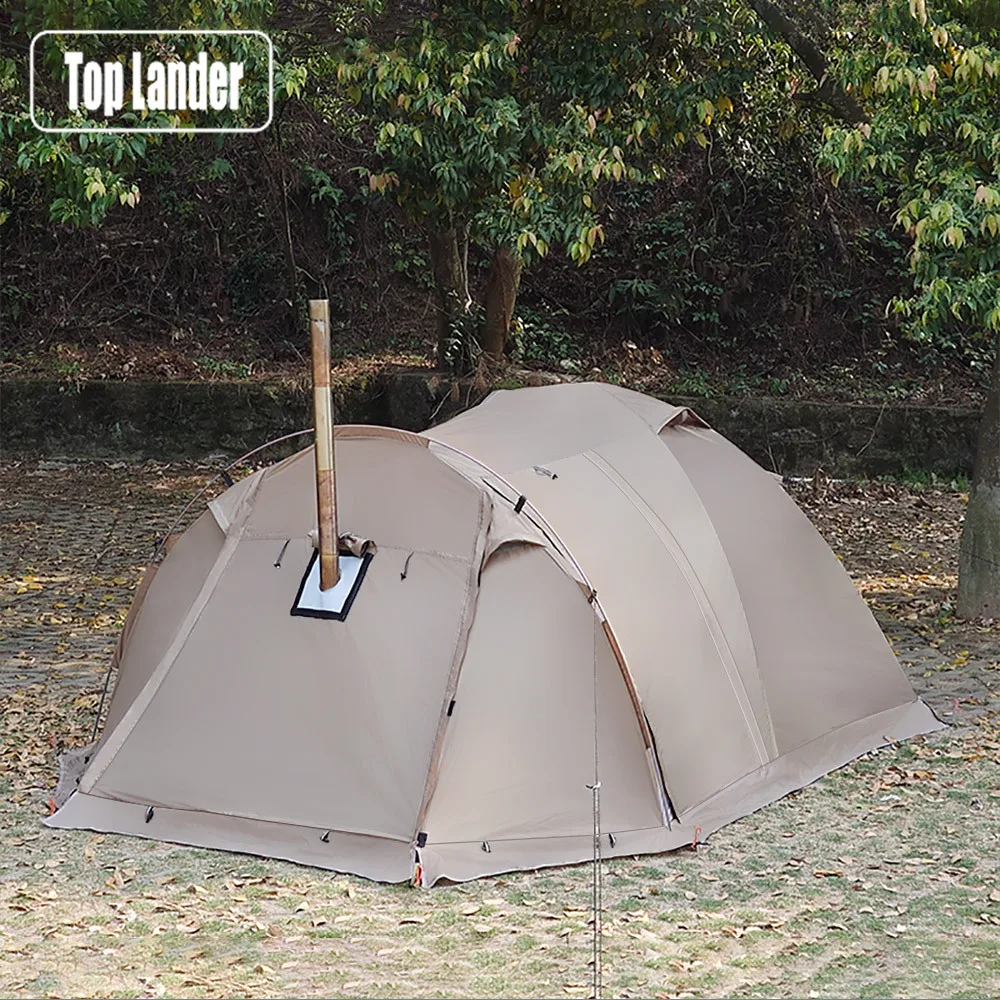
5. External Design Features: Enhanced Protection and Utility
Four-season tents incorporate specialized external design features that transform their protective capabilities in harsh environments. These elements work together to create a comprehensive defense system against extreme conditions.
The flysheet design on four-season tents extends much closer to the ground than on three-season models, often with only a few inches of clearance. This near-complete coverage serves multiple purposes:
- Prevents wind-driven snow from entering beneath the fly
- Creates a protected dead air space for improved insulation
- Reduces ground-level drafts that sap body heat
- Provides enhanced protection from blowing debris
Many true winter expedition tents incorporate snow skirts or valances—fabric extensions that either lie flat on the snow surface or can be buried with snow to create a complete seal against driving winds. This feature provides significant protection by:
- Eliminating wind infiltration under the tent edges
- Creating a stabilizing anchor in snow environments
- Preventing heat loss through ground-level draft penetration
- Offering additional protection during sudden weather changes
Vestibules in four-season tents receive special attention in their design, with significantly more substantial structures than found on three-season models. These protected areas typically provide:
- Larger covered space for gear storage (often 8-12 square feet vs. 4-7 in three-season models)
- More robust structural support to handle snow loading
- Higher clearance for ease of movement during extended stays
- Secondary entrances for versatility in changing wind directions
The weather resistance and durability of camping tents for extreme conditions depends heavily on their anchoring systems. Four-season tents feature:
- More numerous guy-out points (typically 8-12 vs. 4-6 on three-season tents)
- Reinforced attachment points rated for significantly higher loads
- Reflective guy lines for visibility in low-light winter conditions
- Multiple connection points for specialized snow and ice anchoring systems
These comprehensive external protection systems create a noticeable difference in performance compared to standard camping tents. While a three-season tent might withstand brief exposure to moderate winter conditions, 4-season winter 2-person tents with proper external features can provide reliable protection during multi-day storms with sustained high winds and heavy snow accumulation.
6. Interior Features: Optimizing Livability in Harsh Environments
The interior design of four-season tents reflects the practical realities of extended stays in challenging conditions. When confined by severe weather, these purpose-built features transform basic shelter into livable space.
Four-season tent geometries typically incorporate steeper wall angles than their three-season counterparts. This design choice serves multiple purposes:
- Prevents snow accumulation that could compromise structural integrity
- Creates more usable interior volume despite compact footprints
- Improves headroom for extended periods of confined activity
- Reduces condensation by minimizing contact between occupants and tent walls
Headroom considerations receive special attention in four-season designs, with many models featuring:
- Central heights of 40-45 inches (101-114 cm) even in compact models
- Extended high zones rather than single-point peaks
- Sustained vertical clearance across usable floor areas
- Strategic pole placement that maximizes interior volume
Storage solutions in winter expedition tents reflect the increased gear requirements of cold-weather camping:
- More numerous interior pockets (often 6-10 vs. 2-4 in three-season tents)
- Specialized gear lofts designed to hold items off the floor
- Reinforced hanging points for lanterns and equipment
- Integrated systems for drying damp clothing
Door designs for winter camping tents prioritize functionality in challenging conditions, featuring:
- Oversized zipper pulls that accommodate gloved hands
- Smooth-running zippers with anti-freeze coatings
- Multiple closure options for ventilation flexibility
- Strategic positioning to minimize snow entry during access
These interior features combine to create significant differences in usability during extended stays. While a standard tent might feel claustrophobic after a day of confinement due to weather, a properly designed four-season shelter provides:
- Approximately 15-25 square feet (1.4-2.3 square meters) of usable space per person
- Sufficient volume for sitting upright throughout most of the tent
- Organized storage that keeps essential gear accessible
- Functional living systems that support extended occupancy
For adventurers facing potential multi-day storms or challenging high-altitude conditions, these interior design elements transform from mere conveniences into essential components of a safe, manageable expedition strategy.
7. Performance Benefits in Action: Conquering Extreme Conditions
The true value of four-season tent engineering becomes evident when these shelters face the uncompromising challenges of extreme environments. The integration of specialized features creates performance capabilities that far exceed conventional camping equipment.
Wind resistance represents one of the most critical performance advantages of four-season tents. Their aerodynamic profiles and structural integrity enable them to withstand conditions that would destroy standard shelters:
- Sustained winds of 40-60 mph (64-97 km/h) without structural compromise
- Gust tolerance exceeding 75 mph (121 km/h) in properly anchored expedition models
- Minimal fabric flutter that reduces noise and material fatigue
- Stability that doesn’t require constant readjustment during storms
Snow load capacity demonstrates another fundamental advantage. While a standard tent might collapse under even modest accumulation, four-season tents handle substantial weight:
- Static snow loads of 20-40+ pounds (9-18+ kg) distributed across the structure
- Resistance to gradual loading during ongoing snowfall
- Ability to shed accumulation through steep wall designs
- Structural integrity that prevents catastrophic collapse
The navigation of nature’s fury with durable tents depends heavily on their thermal efficiency. Four-season models create significant warmth advantages:
- Temperature differentials of 15-25°F (8-14°C) between inside and outside
- Reduced wind chill effect through complete draft elimination
- Heat retention that supports comfortable sleeping in sub-freezing conditions
- Condensation management that keeps interiors dry despite temperature differences
These performance benefits translate directly into practical advantages in challenging scenarios:
- Multi-day storm protection during alpine expeditions
- Safe shelter during unexpected weather changes at high altitudes
- Reliable protection for winter base camping activities
- Secure refuge during extreme temperature fluctuations
While the specific performance capabilities vary across different four-season tent designs, all share the fundamental ability to maintain structural integrity and protective function in conditions that would render standard camping equipment useless or dangerous.
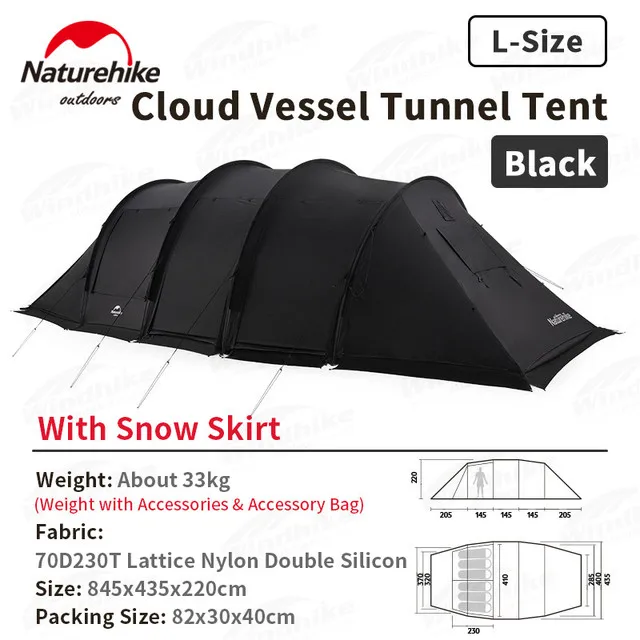
8. Selecting Your Four-Season Fortress: Decision Factors
Choosing the right four-season tent requires matching specific design characteristics to your intended usage scenarios. This decision process involves several key considerations that balance protection, practicality, and performance.
The primary expedition type significantly influences appropriate tent selection:
| Activity Type | Recommended Design | Key Features to Prioritize |
|---|---|---|
| High Altitude Mountaineering | Geodesic or Semi-Geodesic | Maximum wind stability, minimal weight |
| Winter Base Camping | Extended Dome or Tunnel | Larger interior space, robust snow load capacity |
| Mixed Alpine Expeditions | Hybrid Designs | Balanced weight-to-strength ratio, versatility |
| Solo Winter Trekking | Compact Dome | Simplified setup, moderate weight savings |
Weight considerations vary substantially across four-season categories, with important tradeoffs:
- Ultralight alpine models: 4-6 pounds (1.8-2.7 kg)
- Standard mountaineering tents: 6-9 pounds (2.7-4.1 kg)
- Expedition base camp models: 9-15+ pounds (4.1-6.8+ kg)
The selection between single-wall and double-wall construction represents another critical decision point:
- Single-wall designs save weight (typically 1-3 pounds/0.5-1.4 kg lighter) but manage condensation less effectively
- Double-wall models offer superior moisture management but add weight and setup complexity
- Hybrid designs provide partial double-wall construction in critical areas with single-wall in others
Space requirements deserve careful consideration based on:
- Number of occupants (typically 1-3 for technical alpine tents)
- Duration of intended stays (longer trips benefit from additional space)
- Expected gear volume (winter equipment requires substantially more storage)
- Anticipated confined time during storm conditions
Finding the best all-season tent with performance, durability and value involves balancing these factors with your specific needs. For technical alpine pursuits, weight savings might justify compromises in interior space. For basecamp-style winter camping, additional comfort from larger interiors may outweigh weight penalties when loads are distributed among group members.
Mountaineering tents specifically designed for high-altitude expeditions represent the most specialized category, with designs optimized for extreme conditions at the expense of versatility in milder environments.
Heavy Duty 4 Season Tent, Mountaineering Tent, Winter Camping Tent
$870.40 Select options This product has multiple variants. The options may be chosen on the product pageUltralight Backpacking Tent, Ultralight Dome Tent, Winter Camping Tent
Price range: $369.63 through $370.07 Select options This product has multiple variants. The options may be chosen on the product pageHeavy Duty 4 Season Tent, Ultralight Freestanding Tent, Winter Camping Tent
$3,722.66 Select options This product has multiple variants. The options may be chosen on the product pageHeavy Duty 4 Season Tent, Winter Camping Tent
$638.69 Select options This product has multiple variants. The options may be chosen on the product pageHeavy Duty 4 Season Tent, Winter Camping Tent
$5,109.59 Select options This product has multiple variants. The options may be chosen on the product pageBackpacking Tent with Vestibule, Heavy Duty 4 Season Tent, Trekking Pole Backpacking Tent, Winter Camping Tent
Price range: $257.52 through $537.51 Select options This product has multiple variants. The options may be chosen on the product page
9. Understanding Trade-Offs: Balancing Performance with Practicality
While four-season tents provide unmatched protection in extreme environments, they inevitably involve certain compromises. Understanding these trade-offs helps outdoor enthusiasts make informed decisions about when specialized equipment is truly necessary.
The weight difference between four-season and three-season tents represents one of the most significant considerations:
- Four-season two-person tents typically weigh 6-9 pounds (2.7-4.1 kg)
- Comparable three-season models often weigh just 3-5 pounds (1.4-2.3 kg)
- This weight penalty increases with tent size and protection level
- Extended expeditions must factor this additional weight into overall load planning
The cost implications of specialized winter tent construction are substantial:
- Entry-level four-season tents start around $300-400
- Mid-range expedition models typically cost $500-800
- Premium alpine shelters can exceed $1,000
- Specialized materials and construction techniques drive this price premium
Ventilation performance across different climate conditions creates another important trade-off:
- Features optimized for winter conditions may create excessive heat retention in milder weather
- Limited mesh reduces airflow during warmer conditions
- Adjustable systems add complexity to setup procedures
- Mastering tent insulation for year-round camping requires understanding these limitations
Setup complexity increases with four-season designs:
- More poles to manage (typically 4-6 vs. 2-3 in three-season tents)
- Additional guy lines require proper tensioning (often 8-12 vs. 4-6)
- Proper anchoring becomes critical for safety rather than optional
- Setup times may double or triple in adverse conditions
For many outdoor enthusiasts, these trade-offs make four-season tents impractical for general use. The specialized nature of these shelters—optimized for extreme conditions—creates inherent compromises in versatility, convenience, and cost-effectiveness for more moderate environments.
Rather than viewing these limitations negatively, they’re best understood as the natural result of purpose-driven engineering. Four-season tents sacrifice versatility and convenience to excel in the specific conditions for which they’re designed, making them the right tool for specific challenges rather than universal solutions.
10. Essential Accessories and Maintenance: Maximizing Your Investment
Proper accessories and maintenance practices significantly extend the functional lifespan of four-season tents while enhancing their performance in challenging conditions. This investment protection approach begins with essential complementary equipment.
Critical accessories for four-season tent systems include:
- Custom-fitted footprints that provide additional ground protection
- Specialized snow/sand stakes with superior holding power
- Guyline extensions for deep snow deployment
- Comprehensive repair kits with materials suited for cold-weather field repairs
- Tent-safe sealant products for periodic waterproofing maintenance
Proper maintenance protocols for four-season tents involve several key practices:
- Complete drying before storage to prevent mildew and material degradation
- Careful cleaning that removes contaminants without damaging waterproof coatings
- Regular inspection of stress points, seams, and zippers
- Prompt repair of minor damage before it compromises structural integrity
- Appropriate storage in dry, cool conditions away from direct sunlight
Between expeditions, proper storage techniques preserve material integrity:
- Loose packing rather than tight compression
- Clean, dry condition confirmation before long-term storage
- Pole storage in partially assembled state to reduce elastic cord tension
- Separation of components to prevent material transfer or damage
- Climate-controlled environment whenever possible
For comprehensive four-season tent maintenance guidance, specific repair techniques should be mastered for field emergencies:
- Temporary pole splinting methods
- Fabric patch application in cold conditions
- Zipper repair and maintenance procedures
- Grommet and attachment point reinforcement
- Seam sealing in challenging environments
With proper accessories and maintenance, quality four-season tents can provide reliable service for 5-10 years of regular use in extreme conditions, representing excellent long-term value despite their higher initial investment compared to standard camping equipment.
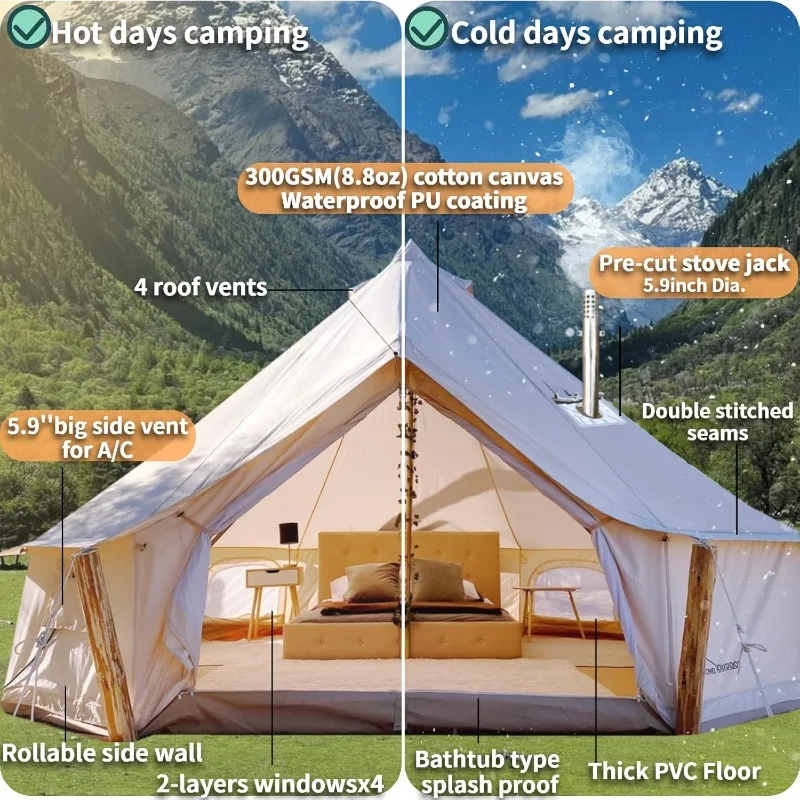
11. Are Four-Season Tents Worth the Investment for Casual Winter Camping?
For occasional winter campers, determining whether a true four-season tent justifies its considerable cost requires honest assessment of actual usage conditions and realistic alternatives.
True four-season tents become essential when facing:
– Temperatures consistently below 20°F (-7°C)
– Potential for significant snow accumulation (6+ inches/15+ cm overnight)
– Exposure to sustained winds exceeding 25-30 mph (40-48 km/h)
– Remote locations where shelter failure creates safety hazards
For more moderate winter conditions, several alternatives may provide sufficient protection:
– Extended three-season tents with additional guylines
– Three-season tents combined with well-designed tarps for wind/snow protection
– Multi-season tents designed for variable climates that balance features
The cost-benefit analysis for occasional users hinges on risk assessment:
– Proximity to safety during planned trips
– Weather predictability in chosen environments
– Personal comfort requirements and cold tolerance
– Potential for conditions to deteriorate beyond forecasts
For weekend winter camping in established areas with reliable weather forecasts and temperatures rarely dropping below 15-20°F (-9 to -7°C), the full capabilities of expedition-grade four-season tents may remain largely unused. In these scenarios, the significant price premium becomes difficult to justify for purely functional reasons.
However, when winter camping involves remote locations, rapidly changing conditions, or multi-day commitments with no easy retreat options, a proper four-season tent transforms from luxury to necessity. The additional cost represents reasonable insurance against potentially dangerous shelter failure.
12. How Do Single-Wall and Double-Wall Four-Season Tents Compare?
The choice between single-wall and double-wall construction represents one of the most significant decisions when selecting a four-season tent. Each design approach offers distinct advantages and limitations suited to different expedition styles.
| Design Aspect | Single-Wall Tents | Double-Wall Tents |
|---|---|---|
| Weight | 30-40% lighter (4-6 lbs/1.8-2.7 kg) | Heavier (7-9+ lbs/3.2-4.1+ kg) |
| Packed Size | More compact | Larger packed volume |
| Setup Speed | Faster (single unit) | Slower (multiple components) |
| Condensation Management | Limited (relies on fabric breathability) | Superior (air gap between layers) |
| Insulation | Moderate | Better thermal efficiency |
| Durability | Variable (depends on fabric quality) | Generally more robust |
| Versatility | Limited across seasons | More adaptable to varying conditions |
Single-wall tents excel in situations where weight and setup speed are paramount concerns:
– Alpine climbing with significant approach distances
– Technical mountaineering with limited carrying capacity
– Fast-and-light winter expeditions
– Solo winter adventures
Double-wall designs provide advantages for:
– Extended base camping in severe winter conditions
– Multi-week expeditions with limited tent drying opportunities
– Situations with significant temperature fluctuations
– Multiple occupants generating more interior moisture
The fundamental difference in condensation management creates the most noticeable performance distinction. Single-wall tents rely entirely on fabric breathability and ventilation systems, which can be overwhelmed during extended use, particularly with multiple occupants. Double-wall designs create an insulating air gap that significantly reduces condensation transfer to the interior.
Understanding how snow tents differ from regular models includes recognizing that premium single-wall tents often incorporate advanced materials with better breathability and mechanical venting systems that partially overcome their inherent limitations, though typically at increased cost.
For most winter campers who prioritize overall comfort and moisture management during multi-day trips, double-wall designs generally provide superior performance despite their weight penalty. However, for technical pursuits where every ounce matters, modern single-wall tents offer compelling advantages when used with proper ventilation techniques.

